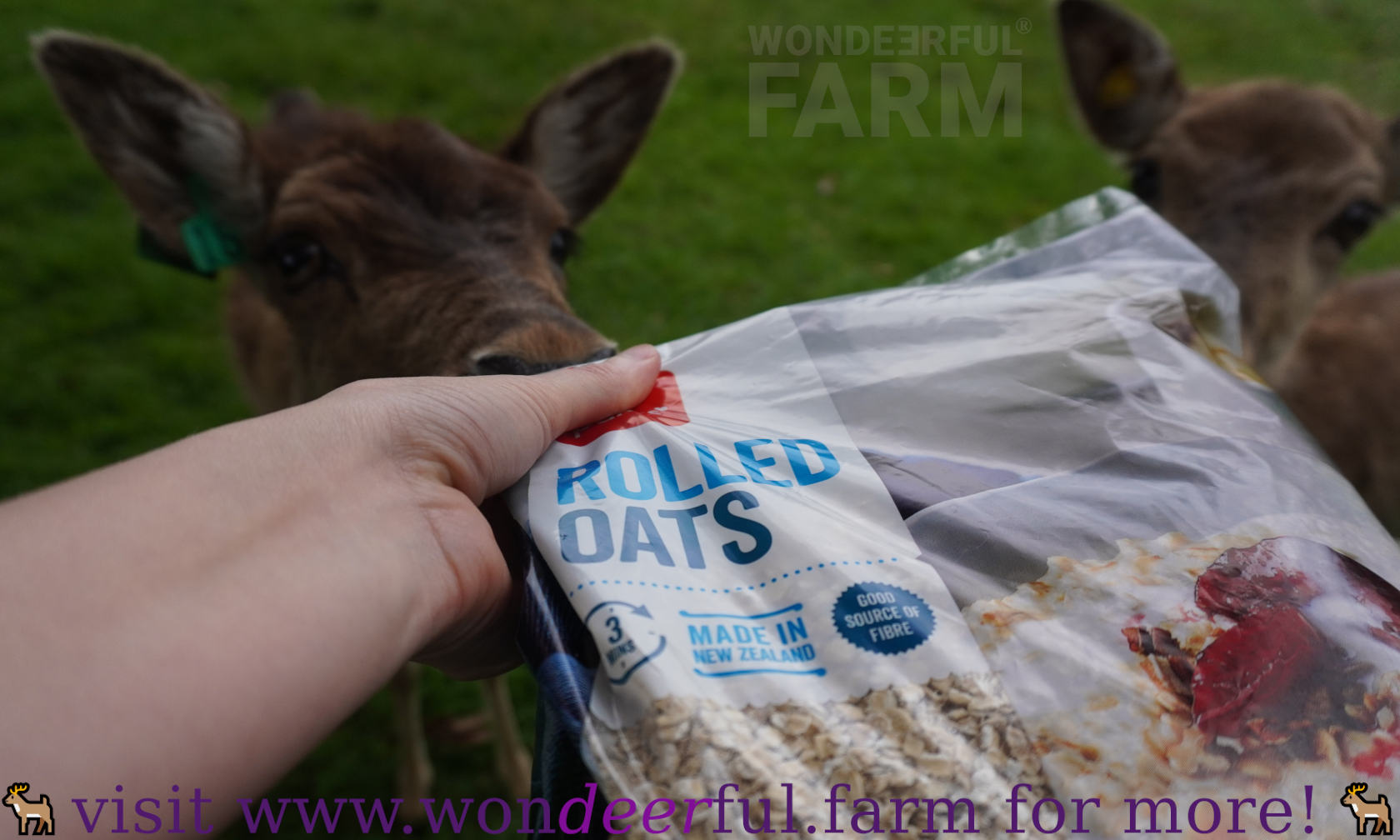Oatmeal is breakfast of choice for many people, it’s nutritious and tasty. But will deer eat oatmeal? Can you feed deer uncooked raw oats, oat porridge? Your favorite cereal? Let’s find out! We’ll also cover planting oats in food plots for deer.
- Deer can be fed plain rolled oats or oatmeal
- Nutritional benefits of oats for deer
- Benefits of planting oats for deer
Coarsely milled oats are probably the best food you can give deer, aside from specifically formulated deer pellets. If you sprinkle raw oat flakes they’ll lick them off the ground, if you throw a lump of porridge on the grass they’re also likely to eat it, might be a tiny bit suspicious at first. Finally, food in the bowl is not exactly what wild animals are used to, so that might take a while.
Deer can be fed plain rolled oats or oatmeal
The key is making sure the oats are fresh and mold-free. Moldy oats may be dangerous for deer to eat.
Oats can be fed dry, cooked or made into a slurry (mixed with water but not cooked). If feeding in winter, it’s a good idea is to add a tiny bit of salt as deer crave that for lacking many nutrients that time of the year.
Deer licking rolled oats off the grass

Deer eating cooked oats
Oat flakes are good for these animals, and they love them too.
In our video above, animals are eating simple oats, cooked on water, with a bit of nuts and fried cranberries on top (they’re spoiled).
We wouldn’t recommend any breakfast cereal though, because those can contain a lot of sugar, bits of chocolate and artificial colors. Doesn’t mean deer won’t eat it, on Christmas our gourmet deer were even interested in gingerbread house:
Gingerbread house was a photo set up, they didn’t get to finish eating it. Don’t try this with your wild deer. Feed them oats, if anything.
Nutritional benefits of oats for deer
There are many health benefits of eating oats for deer. The six required nutrients for deer are protein, fat, carbohydrates (fiber, sugar, starch), minerals, vitamins, and water.
Oats tick a few boxes:
- Being high in fiber content, oats promote healthy digestion and avoid gastrointestinal issues.
- Oats contain a good amount of protein to support muscle growth and repair.
- Oats are high in carbohydrates, which means deer can satiate faster and keep warm in winter.
- Oats contain essential vitamins and minerals that promote overall health.
Benefits of planting oats for deer
Planting oats in food plots is a common practice among hunters and wildlife enthusiasts, as it provides numerous benefits for both deer and the ecosystem.By planting oats in food plots wildlife enthusiasts can help improve the overall health of the deer population, ensuring that deer have a reliable source of food, even during periods of low natural food availability.
For hunters, it can help to attract and hold deer in a specific area, which makes it easier to predict where deer will be and to plan hunting strategies accordingly.
If you are interested in planting oats in food plots for deer, there are a few things to consider.
1. ✔️ Firstly, it is important to choose a high-quality seed variety that is specifically designed for deer food plots. This will ensure that the oats are of a high quality and are well suited to the needs of deer.It’s crucial to choose an oats variety that is tolerant to cold weather. You can determine this by reaching out to your local extension agent or seed provider. Additionally, oats do not grow well in soils that are constantly wet and poorly drained. So make sure to plant them in areas with proper drainage.
2. 🕐 Secondly, it is important to plant oats at the right time, taking into account the local climate, soil conditions, and the timing of natural food availability. The typical planting season for oats is in late summer. However, the specific time frame varies based on the local climate.For example, for those in northern regions of the United States, it’s best to plant oats in late August or early September, while in warmer climates, planting can occur from September to early October. Another option for planting oats is to use the method of frost-seeding in April, if you are looking for spring/summer forage. However, if your primary objective is to increase forage production during the summer, other forage legumes such as soybeans (we are supplement feeding our deer soy whey and deer do great on it!) and cowpeas might be a better choice.
3. 🧪 Finally, test your soil pH. You can then add the right amount of lime and/or fertilizer to your soil if required. According to Whitetails Unlimited, “Most deer forage crops grow best at pH values that are slightly acidic, between 5.8 and 6.5. Adjusting soil pH with lime within this range maximizes growth and increases yield, fertilizer efficiency, palatability of crops, and herbicide effectiveness.”
One of the key benefits of planting oats is their quick growth and germination rate. Within just two weeks of planting, the oat seeds will begin to sprout and produce green shoots.
Oats are a fantastic choice for deer and your wallet. They are affordable and have a proven track record of being appealing to deer.
Wondering what other food deer might like to eat?
Read our overview post ‘What do deer eat’.
If you have any more questions regarding 🦌 feeding deer oats or oatmeal, feel free to ask in the comments below.
Disclosure: This website is also a participant in the Amazon Services LLC Associates Program. Some of the above links are ‘affiliate links’, meaning, at no additional cost to you, we may earn a commission if you make a purchase.
Last modified 2024-02-11 at 12:19







































![Air gun 101: The differences between .177 & .22 – Which jobs they do best ? [Infographic]](https://airgunmaniac.com/wp-content/uploads/2020/09/g44-150x150.jpg)



